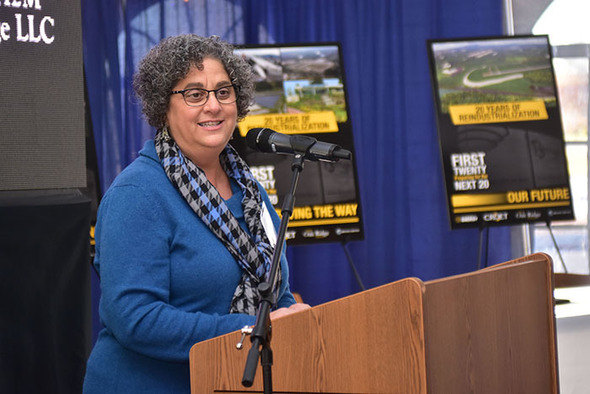
A rendering of East Tennessee Technology Park, the former K-25 site, in 2020, when cleanup there is scheduled for completion. ETTP offers robust infrastructure and multiple parcels spanning hundreds of acres, capable of attracting and supporting large-scale industry, according to DOE. (Photo courtesy DOE)
Note: This is an edited version of a story by the U.S. Department of Energy Office of Environmental Management.
A re-industrialization program that was the first of its kind and converts federal property to private-sector use celebrated 20 years this month.
The re-industrialization program was designed to attract new industries and jobs to a former uranium enrichment complex.
Through the program, the U.S. Department of Energy has transferred hundreds of acres to the Community Reuse Organization of East Tennessee, or CROET, and the City of Oak Ridge to create two private-sector industrial parks, the 1,200-acre Heritage Center and the 1,000-acre Horizon Center.
Heritage Center is at the former K-25 site, which was built during World War II and was once used to enrich uranium in west Oak Ridge. Horizon Center is a few miles east of Heritage Center.
The re-industrialization program launched in 1996, and community leaders and area economic development officials celebrated its 20th anniversary on December 8. Among those participating were CROET and the U.S. Department of Energy’s Oak Ridge Office of Environmental Management, or OREM.
“The past 20 years have been an incredible journey,” said Sue Cange, DOE Environmental Management principal deputy assistant secretary. Cange, who once worked in Oak Ridge but was recently named to the EM post in Washington, D.C., was a member of the task force formed to kick-start the re-industrialization program in Oak Ridge.
“The leadership at the time were trailblazers, and their courage to embrace new approaches led to significant achievements and has positioned the community for greater success in the future,” Cange said.
OREM has conducted significant cleanup across the East Tennessee Technology Park, which includes the Heritage Center, with the goal of completing its work there in 2020. The re-industrialization program transfers properties after OREM removes old, contaminated buildings and cleans parcels.
This approach led to 20 companies moving to the Heritage Center, accounting for more than 200 private-sector jobs. As ETTP cleanup advances, larger tracts of land are available for commercial use.
The land transfers have paid significant dividends. DOE has avoided $110 million in costs associated with overseeing land, infrastructure, and onsite emergency services.
Reasons to be optimistic about the program’s impact continue to grow. LeMond Composites announced recently it would be the newest addition to the Horizon Center. The company has licensed Oak Ridge National Laboratory carbon-fiber technology to manufacture a new breed of less expensive carbon fiber bicycles. Its $125 million investment is expected to create more than 240 new jobs over the next five years.
“OREM is cleaning land in a way that makes the site reusable and marketable for the community to begin a new chapter there,” Cange said. “At its heart, Oak Ridge’s re-industrialization program has always been about giving back to the community, and through our cleanup progress and transfers, we are setting the stage for exciting growth in the region.”
Watch a video about the re-inudustrialization program here.

EM Principal Deputy Assistant Secretary Sue Cange speaks at the reindustrialization program’s 20th anniversary event. (Photo courtesy DOE)
This story was first published in an electronic newsletter on December 15 from the U.S. Department of Energy Office of Environmental Management. Ben Williams of the Oak Ridge Site contributed to that newsletter. The story has been edited here.
Leave a Reply